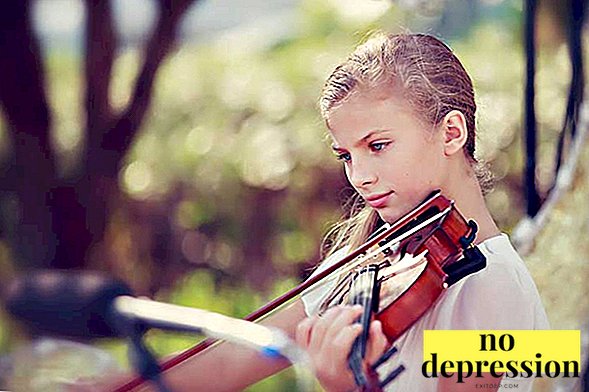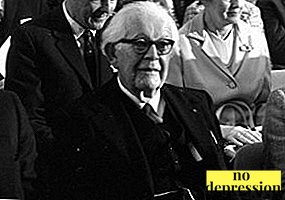Human psychology very complex and mysterious. People don't always say what they really think.
Different conditions force them to hide their true feelings: fear of losing their job or friendship, the desire to gain, etc.
In order to understand the true intentions of the individual, it is enough to study the basics nonverbal communication, that is, sign language and facial expressions.
What it is?

Body language, gestures and facial expressions refers to non-verbal communication.
It is scientifically proven that a person can pronounce up to 40 thousand words daily.
However, it is very difficult to communicate only with words. Gestures and facial expressions reinforce human speech, and sometimes completely replace it.
Non-verbal communication involuntarily, his cannot be controlled. Therefore, an attentive interlocutor will always be able to notice the falsehood in communication. In gestures and facial expressions there are signs of the following types:
- Physiological. This redness, tremor, excitement and other reactions, not subject to consciousness.
- Unconscious gesticulation: shaking his foot, rubbing his face, etc.
- Conscious signals: gestures, facial expressions used to convey information.
Nonverbal communication
Non-verbal communication in psychology is called speechless communication, that is, communication using facial expressions, gestures, intonation, body movement.
Knowledge of non-verbal language allows not only to better understand the interlocutor, but also to know his attitude to what was said before he expresses it with words.
Thus, speechless communication performs the following functions:
- establishes contact between communicating;
- strengthen verbal expressions, enrich the communication process;
- Express the emotional state of the interlocutor.

Nonverbal communication can be of the following types:
- Kinetic. This is a peculiar set of gestures, postures, facial expressions, which should be interpreted unequivocally. These signs are an expression of a particular culture.
- Tactile signs. These are touches that are used in fairly close communication (friendly, loving, professional).
- Sensory perception. Communication is based on the perception of smells, taste, color, etc.
- Paraverbal communication. It implies expression of voice timbre, intonation, speech rhythm during communication.
- Proxemics. Communication is evaluated in terms of distance between the interlocutors. The distance can be personal, professional and public.
In everyday communication, a person tries to understand the interlocutor, primarily through gestures and facial expressions. The science that studies such communication is called physiognomy.
Ambiguity of body language

Why is body language ambiguous?
In the process of communication, a person perceives not individual words or gestures, but holistic picture.
The fact that the interlocutor does not finish speaking can be understood by the expression of the face or movements.
However, sign language not always unequivocal. For example, crossed arms in psychology mean secrecy and estrangement. But a person may just freeze, so he wraps his arms around himself.
If a person rubs his nose or forehead, it is interpreted as the fact that he is lying. But he may just have a headache or a scratching nose. Yawning is not always a sign of getting bored. Perhaps the room just does not have enough oxygen.
Also, many scammers have learned to use non-verbal means to deceive. A sincere and open look, a smile bribes the victim and misleads her.
At the same time, a person in unfamiliar surroundings may behave squeezed and strictly, and under arrogance there may be a lack of self-confidence, but this does not indicate his bad attitude towards others.
Meaning of gestures

Interpret gestures and facial expressions correctly can learn.
This will require some experience and theoretical knowledge.
If we discard some nuances, then in psychology there is a certain interpretation of gestures and facial expressions, according to which to conclude about the interlocutor and his attitude.
Human leader
A human leader can always be identified by his non-verbal signs. His gestures are always unequivocal, accurate and express confidence.
The main psychological signs of a leader:
- Firm handshake. The hand of a confident person is always on top, he is the first to finish the handshake.
- Various attributes. Managers very often hold a pen in their hand with which they point.
- Domination gestures. If the head crosses his arms over his chest, his thumbs will always point upwards. This is evidence of its leading position.
- Clear and monosyllabic gestures. A confident person never twitches his nose, does not rub his forehead, does not straighten his clothes. His movements are clear and monosyllabic.
Signs of lying

How to identify a lie by facial expressions and gestures? That the interviewer is insincereCertain signs indicate:
- Rubbing the nose, eyes while talking.
- Relaxing scarf collar.
- Looking away to the side. Sincere companion always looks the other in the eye.
- A shaky, uncertain voice, or, conversely, rapid speech, as if memorized.
- Involuntary smile out of place, which gives excitement.
- Fussy movement, shifting items on the table.
Communication between a man and a woman
Perhaps most often non-verbal means of communication are used in communication between men and women. This happens unconsciously, as people sympathetic to each otherfeel free to express it with words.
Some gestures and facial expressions are innate, they were used even by distant ancestors to attract the opposite sex.
Ways of expressing male sympathy
What are the gestures of a man if he likes you?

Men are secretive and shy creatures. Often they do not express their sympathy for a woman out of modesty or fear of refusal.
A woman can understand that she likes a man for the following non-verbal signs:
- Permanent presence nearby. He somehow in an incomprehensible way is in the right place at the right time to help.
- Smile at the meeting. If a girl likes her, then a man cannot hold back joy when she sees her.
- Observation. Men love with their eyes, so they constantly look at the object of their sympathy. However, seeing that his gaze is caught, the young man looks away because of embarrassment.
- Changing speech. A man in love will speak uncertainly, stumble or speak out of place.
- Nervousness behavior. When communicating, a man will pull a tie, shift items on the table, correct clothes.
- Reduced voice timbre.
- Violation of personal space. The man tries to be closer to the woman, to touch her. He seeks to help collect things, file a coat.
Reading women's secrets
Women are much more likely than men to use sign language and facial expressions. This is due to the belief that the girl should not be the first to admit her sympathy.
Therefore, they often send different signs, provoking a young man to the first step. She sends some signs unconsciously, and others - quite consciously.
Signs of female sympathy:
- Looks out of a dummy and eye abduction.
- Throwing hair, curl curl on the finger.
- Easy smile and lip biting.
- Loud conversations, pronounced gesticulations, beautiful posture, smooth gait.
- Requests for help.
- Intentionally flirting with another man in the presence of an object of sympathy to cause jealousy.
- Ostensibly random touch.

However, especially shy girls will to hide their attitude in every possible way. To understand that they have warm feelings for a man can be on some grounds:
- avoiding meetings, looking away;
- deliberate rudeness, a demonstration of indifference.
At the same time, her trembling voice, reddening of the face, uncertain movements, speech, fussiness in the presence of the man she liked are given out.
Examples of characters
Why does a person gesticulate while talking? In order to understand people and build interpersonal relationships, it is important to know what gestures mean. If the individual is in conversation gesticulating heavily, it means his emotional attitude.
He is trying to strengthen the value of his speech, to bring information to the consciousness of people. Usually gestures are used if words alone are not enough.
Open arms Signal about joyful mood. Aggression expressed with sharp short movements.
The main talking gestures used in communication:
- Scratching. If a person rubs his earlobe, he wants to speak. Rubbing the neck or cheeks indicates uncertainty or distrust of the partner.
- Crossing limbs. Crossed arms or legs symbolize energy closure. The person either does not want to come into contact with an opponent, or tells a lie. Often, people cross their arms in an unfamiliar environment where they feel insecure. Also, the hands on the chest speak of distrust, a negative attitude towards the opponent. If at the same time clenched fists, then the person is in an extreme degree of tension.
- Coupled fingers. If a man clasps his fingers and holds out in front of him, he is unfriendly. The closer they are to the face, the stronger the negative. Although at the same time the individual can openly smile and agree with the interlocutor.
- Hands behind your back. Arms clasped behind their backs speak of a sense of superior personality. It is open to the opponent, because it does not feel threatened.
If at the same time a person scratches his head, rubs his face, it is, on the contrary, evidence of awkwardness. He thus tries to hide his insecurity.
- Hands in pockets. Such a gesture is evidence of secrecy, attempts to conceal important information. Also shy people keep their hands in their pockets, because they do not know where to put them. Such personalities have shoulders and an uncertain look. Clenched teeth and narrowed eyes with simultaneous placement of hands in pockets speak of anger and rage.
- Open arms. Open hands, palms held up by people who have nothing to hide. They seem to demonstrate the sincerity of their thoughts, the lack of "stone in the bosom." Such a technique is often used by businessmen in negotiations and signing a contract.
- Hands at chest. A man presses his hands to his chest when he declares love or asks for something. Fraudsters do this when they want to get things done. In fact, their intentions are far from good.
- Hands behind head. Such a gesture is peculiar to confident people who feel their superiority. Simultaneous tossing legs to the foot gives an amateur to argue. This posture is annoying to many, usually the boss sits in front of his subordinates. However, such a position of the body takes a man tired of work, trying to relax. This means that he feels comfortable and does not wait for a trick.
- Biting items. Many have the habit of nibbling a pen or pencil during a dialogue. This may mean distrust of what he heard or that the individual reflects on the question. When a person gnaws his fingers, he needs approval or praise.


Sign language very versatile and interesting. It helps to better understand your opponent, to build a trusting relationship or to prevent danger.
After analyzing the movements and facial expressions of the individual, you can easily calculate his next actions. Non-verbal communication is often used by fraudsters and scammers.
However, everyone can apply their knowledge in everyday life. Should also redefine your own habits. Perhaps the manner of keeping your hands in your pockets does not mean anything, but the interlocutor may misinterpret her.
How to learn to read people? Find out from the video:



